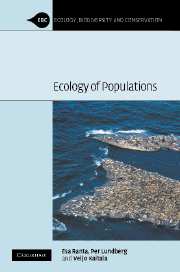Book contents
- Frontmatter
- Contents
- Preface
- 1 Introduction
- 2 Population renewal
- 3 Population dynamics in space – the first step
- 4 Synchronicity
- 5 Order–disorder in space and time
- 6 Structured populations
- 7 Biodiversity and community structure
- 8 Habitat loss
- 9 Population harvesting and management
- 10 Resource matching
- 11 Spatial games
- 12 Evolutionary population dynamics
- 13 Epilogue
- References
- Index
5 - Order–disorder in space and time
Published online by Cambridge University Press: 02 December 2009
- Frontmatter
- Contents
- Preface
- 1 Introduction
- 2 Population renewal
- 3 Population dynamics in space – the first step
- 4 Synchronicity
- 5 Order–disorder in space and time
- 6 Structured populations
- 7 Biodiversity and community structure
- 8 Habitat loss
- 9 Population harvesting and management
- 10 Resource matching
- 11 Spatial games
- 12 Evolutionary population dynamics
- 13 Epilogue
- References
- Index
Summary
In this chapter, we shall continue exploring how large-scale ecological processes may be fundamentally important for our understanding of emergent phenomena in various population systems. The modern ecological literature on spatial population dynamics has drawn our attention to various captivating configurations, such as traveling waves, suggesting that spatially structured populations may become self-organized. Spatial interactions in population dynamics can create a variety of spatial-temporal patterns. Spatial self-organization was first demonstrated in dispersal-coupled predator–prey and host–parasitoid models and we will discuss them first. We then proceed to expand the self- organization on a large scale of redistribution-coupled population processes. We shall finish by discussing data that support some of the theoretical findings.
Spatial interactions in population dynamics can generate a rich ensemble of spatial patterns. One example is traveling waves (Shigesada et al. 1986; Kot 1992; Ranta and Kaitala 1997; Shikesada and Kawasaki 1997; Kaitala and Ranta 1998) and they may appear in the form of wave fronts, periodic waves, spirals, and rings. Other eye-catching patterns are represented by crystal lattices, patches, and spatial chaos (Hassell et al. 1991, 1994; Solé and Valls 1991; Comins et al. 1992; Solé et al. 1992a, b; Solé and Bascompte 1993; Hassell 2000; Bjørnstad and Bascompte 2001). There are no strict definitions for the different spatial configurations emerging due to spatially coupled population renewal, although some attempts to derive more formal approaches to identify the patterns have been presented (Bjørnstad and Bascompte 2001; Bjørnstad et al 2002a; Kaitala 2002).
- Type
- Chapter
- Information
- Ecology of Populations , pp. 98 - 130Publisher: Cambridge University PressPrint publication year: 2005



